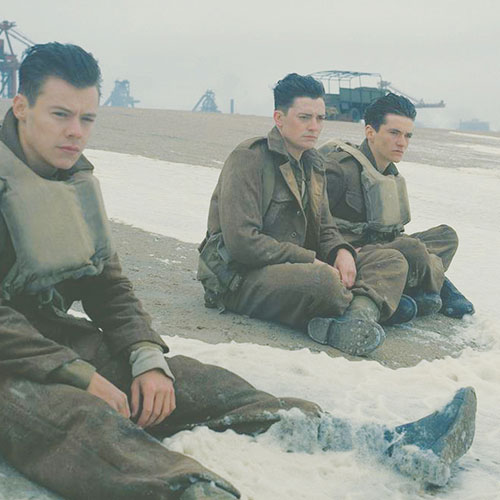FEATURED FILM
Film Review
Dunkirk (PG-13)
Written By Amy Diaz (adiaz@hippopress.com)
Images: Movie Screenshot
British and other Allied soldiers await evacuation from France by sea, with the German army on its way, in Dunkirk, a “you are there” approach to this moment during World War II from Christopher Nolan.
The movie follows three stories: men stuck on the beaches at Dunkirk trying to find a spot on a boat; a small civilian boat crossing the English Channel to join the naval evacuation effort, and pilots sent out as part of the limited air cover for the evacuating soldiers. The stories unfold in different timelines (explained with onscreen text) — a week with the men on the beach, a day with the boat and an hour with the pilots. We bounce between the three plots, which, at points, intersect.
At the beach, lines of scared, exhausted soldiers wait to get on a limited number of ships. We follow soldiers played by Fionn Whitehead, Aneurin Barnard and others as they look for a way onto a boat.
At sea, the owner (Mark Rylance) of a small boat, his son (Tom Glynn-Carney) and his son’s friend (Barry Keoghan) set sail for Dunkirk (Navy officers are about to requisition the boat but Rylance’s character is determined to be at the helm). Soon they find themselves fishing men out of the water and facing enemy fire from the air.

In a dogfight with that enemy are Farrier (Tom Hardy) and Collins (Jack Lowden). They are two of a relatively small number of planes covering the ships crossing the channel and the men on the beach.
Back on the beach is Navy officer Commander Bolton (Kenneth Branagh), who we go to for the state of the situation: the sudden pause in the German advance is the main reason the Allies have not yet been overrun; the geography of the coast is making evacuation difficult; Churchill is just hoping to evacuate enough of the army to have something left to defend the homeland, and most of the Navy and Air Force will not be sailing/flying to the rescue because they are being held back for the battle for Britain.
Dunkirk is good at conveying the feelings men in this situation might have — the mix of endless waiting and fear. Read the history of the evacuation of Dunkirk and you get the big picture idea of the troops doing this and Churchill ordering that. Here, you see individual men and their attempts to make it through the week. Without being melodramatic, the movie gets to the high drama of the situation, even when that situation involves long stretches of guys just sitting around.
Because of the structure, the movie is also able to give us a lot of individual stories and do it very quickly. Without much backstory, we’re able to get the basics of the characters and their motivations and experiences.
The structure is not, however, a complete success. Something about the way this story is told, for me, actually sucked some of the energy out of this fraught, fascinating part of history. Perhaps because I found myself spending time on the relationships of the storylines (and their timelines) to each other, I felt, at times, impatient with stretches of the movie. The war and the Dunkirk evacuation don’t need a lot of self-conscious storytelling business. And the mix of scenes and plots here — the up-close, hear-the-breaths scenes of two guys try to sneak onto a ship and the more straightforward “Prof. Kenneth Branagh’s Expositional History Minute” scenes, for example — are occasionally clunky.
I did not love this movie the way that some reviewers I’ve read or heard apparently did (avoiding reviews has been futile for this movie; I agree with some commentators on the Pop Culture Happy Hour podcast that Dunkirk might require a second viewing, both to get past the structure and the hype). I liked it, but it has flaws. But by the end of the movie, Dunkirk does tell a fairly coherent story, with a final stretch that helps to pull the movie together.
